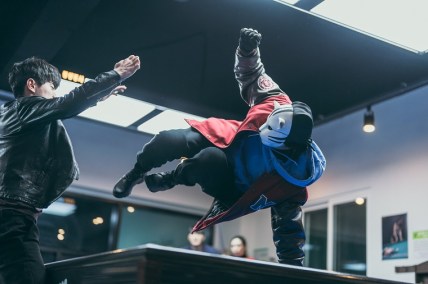Megalobox Blu-Ray Collection Review: Is It Worth a Ringside Seat?
Fifty years after the debut of Ikki Kajiwara’s popular boxing manga, Ashita No Joe, Megalobox brings the iconic boxing series back to television screens for the first time in nearly 40 years. Introducing the modern world to one of Japan’s scrappiest boxers, Megalobox features updates for the modern era, such as the introduction of robotic boxing equipment known as “Gear,” while keeping the spirit of Joe and his team which has entranced and inspired readers for generations. This marriage of old and new results in an exciting series that will have viewers cheering for Joe well before he takes the ring for a championship match.
Plot
In the world of Megalobox, society is divided into two classes: the wealthy “licensed” citizens and the “unlicensed” slum dwellers. Megalo boxing is a popular sport similar to boxing but with fighters wearing mechanical frames known as “Gear.” The protagonist, JNK.DOG, competes in underground megalo boxing matches, though these matches are normally thrown by JNK.DOG at the direction of his trainer, Gansaku Nanbu. After a chance encounter and match with the current megalo boxing champion, Yuri, JNK.DOG is inspired to rise up from his life of poverty and crime, deciding to enter the upcoming Megalonia tournament and defeat Yuri. Aided by Nanbu, a young child named Sachio, and a forged ‘license,’ JNK.DOG takes up the name of Joe as he competes against the world’s greatest megalo boxers for the chance to meet Yuri in the ring.
The story of Megalobox isn’t groundbreaking in its portrayal of a standard shonen underdog storyline, watching as Joe fights unique fighter after unique fighter on his way to the top, but the struggles that each character goes through continually raises the stakes of each subsequent match. The series is not as focused on the technicalities of boxing and combat as the shonen boxing manga Hajime no Ippo, instead focusing on the interpersonal conflicts of the sport. Watching Joe endure physical and emotional beatings will have one rooting for Joe long before he even sets foot in Megalonia.
One of the story’s highlights are the rough and competitive cast of characters. While Joe and Nanbu are obvious reinterpretations of Ashita No Joe’s Joe Yabuki and Danpei Tange, the cast is mainly comprised of original characters, each with their own distinct personalities and reasons for entering the tournament. Watching the characters balance these desires with their own personal concepts of morality pulls viewers into each episode as opponents find their pretentious worldviews shattered against Joe’s earnest fighting spirit.
Visuals
There’s no way to sidestep it: Megalobox is beautiful. One of the first things that will no doubt stand out to a viewer are the backgrounds, which feature rough sketch overlays on top of the finished background art. Combined with the pencil-like texture with which the characters are outlined, these effects provide a rugged and dirty visual style which echoes the harsh lives lived by Joe and his teammates.


While not as flashy or over-the-top as the mobile suits of G Gundam, the Gear of each respective fighter is visually distinctive, though the focus on the top elites at Megalonia unfortunately limits how many different Gears the audience gets to see in action. The Gears are little more than visual flair, as they only accentuate a fighter’s skill rather than providing dramatic transformations or special techniques, but they’re a distinctive element of the series that contributes to each fighter’s visual aesthetic.
However, despite how gorgeous the series is, there’s one glaring problem that’s noticeable from the start of the first episode. Despite being produced in 2018 by TMS Entertainment (LUPIN the Third: The Woman Called Fujiko Mine, Dr. Stone), the series was intentionally produced in standard definition. Series director Yo Moriyama (concept designer Attack on Titan, Kabaneri of the Iron Fortress) could not envision the series in the clean visual style of modern anime, and in his effort to make Megalobox reminiscent of earlier anime productions, downscaled the original footage and upscaled it back. While one can respect Moriyama’s artistic direction, it seems almost criminal for the beautiful visuals of Megalobox to be locked in standard definition. It’s like recording a song, pressing it to vinyl, making a cassette recording of the vinyl, and then releasing the cassette recording as the official version of the song; there’s a sacrifice of quality for artistic intent.
Sound
Every aspect of Megalobox’s sound production is top notch. The soundtrack, produced by Japanese hip-hop artist mabanua and featuring artists such as COMA-CHI, Michael Kaneo, and Kazuhiro Bessho, features treble-heavy beats reminiscent of industrial factories, crunchy guitar riffs, and sharp drum beats which stoke the fighter’s spirit inside the viewer and make him feel connected to Joe’s journey. While it’s easy to simply compare the soundtrack to Samurai Champloo’s hip-hop direction, the soft jazzy undertones and occasional clean instrumentation reinforce the unfortunate circumstances of Joe, Nanbu, and Sachio’s lives, serving to bring an emotional element to the series and anchor it firmly in a modern setting.
The voice acting is another strong point for the series, with actor Yoshimasa Hosoya (Fumikage Tokoyami, My Hero Academia, Robin, Super Smash Bros Ultimate) providing a deeper, but not gritty, voice for the series’ protagonist with actors Shirô Saitô (Sorbe, Dragon Ball Super) and Michiyo Murase (Sucy, Little Witch Academia) bringing heartfelt performances to the roles of Nanbu and Sachio, respectively. While many anime fans tend to prefer listening to the original Japanese audio tracks with subtitles, Megalobox’s dub is a quality production. Many of the performances do not stray from the intent of the Japanese originals: of note are Kaiji Tang’s deep-voiced and hot-headed performance as Joe and Jason Marnocha’s portrayal of Nanbu as he wrestles with his conflicting morals and survival instincts. Each voice actor brings their best to their role and at no point does the dub feel lazy or unsatisfactory and ensures that viewers who prefer to watch the series in English will not be disappointed.
Production Value
The Megalobox Blu-ray comes packaged in a holofoil sleeve, with the case itself including a reversible cover featuring Joe and Yuri in the ring. The Blu-ray also includes interviews with Hosoya, Tang, and a joint interview of the two together, the two Megalobox audio dramas (for more Megalobox goodness), clean versions of the shows openings and endings, an art gallery, and three behind the scenes interviews discussing production, character and background art, and music and sound. For true fans of Megalobox, Viz has also released a limited edition Megalobox Blu-ray which features the aforementioned bonuses as well as an exclusive 128-page booklet featuring art and information about the series. It’s all beautifully packaged, and the inclusion of the audio dramas ensures that fans who purchase the series won’t be missing out the full range of Megalobox media.
The Verdict
Ultimately, the Megalobox Blu-ray is a quality collection of a 13-episode series that any anime fan should check out. While the curious choice to produce the anime in standard definition may be off-putting to some viewers, the personal stories of the characters will be enough to draw them back into the arena for the next episode. Some will come for the fighting, some will come for the production, but most will stay to see Joe rise to the top.
Megalobox was released on June 25, 2019 by Viz Media with a retail list price of $44.98. A review copy of this collection was provided by Viz Media.
More About:Anime









